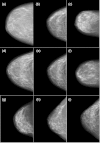Generation of a suite of 3D computer-generated breast phantoms from a limited set of human subject data
- PMID: 23556929
- PMCID: PMC3625240
- DOI: 10.1118/1.4794924
Generation of a suite of 3D computer-generated breast phantoms from a limited set of human subject data
Abstract
Purpose: The authors previously reported on a three-dimensional computer-generated breast phantom, based on empirical human image data, including a realistic finite-element based compression model that was capable of simulating multimodality imaging data. The computerized breast phantoms are a hybrid of two phantom generation techniques, combining empirical breast CT (bCT) data with flexible computer graphics techniques. However, to date, these phantoms have been based on single human subjects. In this paper, the authors report on a new method to generate multiple phantoms, simulating additional subjects from the limited set of original dedicated breast CT data. The authors developed an image morphing technique to construct new phantoms by gradually transitioning between two human subject datasets, with the potential to generate hundreds of additional pseudoindependent phantoms from the limited bCT cases. The authors conducted a preliminary subjective assessment with a limited number of observers (n = 4) to illustrate how realistic the simulated images generated with the pseudoindependent phantoms appeared.
Methods: Several mesh-based geometric transformations were developed to generate distorted breast datasets from the original human subject data. Segmented bCT data from two different human subjects were used as the "base" and "target" for morphing. Several combinations of transformations were applied to morph between the "base' and "target" datasets such as changing the breast shape, rotating the glandular data, and changing the distribution of the glandular tissue. Following the morphing, regions of skin and fat were assigned to the morphed dataset in order to appropriately assign mechanical properties during the compression simulation. The resulting morphed breast was compressed using a finite element algorithm and simulated mammograms were generated using techniques described previously. Sixty-two simulated mammograms, generated from morphing three human subject datasets, were used in a preliminary observer evaluation where four board certified breast radiologists with varying amounts of experience ranked the level of realism (from 1 = "fake" to 10 = "real") of the simulated images.
Results: The morphing technique was able to successfully generate new and unique morphed datasets from the original human subject data. The radiologists evaluated the realism of simulated mammograms generated from the morphed and unmorphed human subject datasets and scored the realism with an average ranking of 5.87 ± 1.99, confirming that overall the phantom image datasets appeared more "real" than "fake." Moreover, there was not a significant difference (p > 0.1) between the realism of the unmorphed datasets (6.0 ± 1.95) compared to the morphed datasets (5.86 ± 1.99). Three of the four observers had overall average rankings of 6.89 ± 0.89, 6.9 ± 1.24, 6.76 ± 1.22, whereas the fourth observer ranked them noticeably lower at 2.94 ± 0.7.
Conclusions: This work presents a technique that can be used to generate a suite of realistic computerized breast phantoms from a limited number of human subjects. This suite of flexible breast phantoms can be used for multimodality imaging research to provide a known truth while concurrently producing realistic simulated imaging data.
Figures





Similar articles
-
An analysis of the mechanical parameters used for finite element compression of a high-resolution 3D breast phantom.Med Phys. 2011 Oct;38(10):5756-70. doi: 10.1118/1.3637500. Med Phys. 2011. PMID: 21992390 Free PMC article.
-
Finite-element modeling of compression and gravity on a population of breast phantoms for multimodality imaging simulation.Med Phys. 2016 May;43(5):2207. doi: 10.1118/1.4945275. Med Phys. 2016. PMID: 27147333 Free PMC article.
-
Population of 224 realistic human subject-based computational breast phantoms.Med Phys. 2016 Jan;43(1):23. doi: 10.1118/1.4937597. Med Phys. 2016. PMID: 26745896 Free PMC article.
-
Advances in digital and physical anthropomorphic breast phantoms for x-ray imaging.Med Phys. 2018 Oct;45(10):e870-e885. doi: 10.1002/mp.13110. Epub 2018 Aug 28. Med Phys. 2018. PMID: 30058117 Review.
-
The advent of anthropomorphic three-dimensional breast phantoms for X-ray imaging.Phys Med. 2020 Nov;79:145-161. doi: 10.1016/j.ejmp.2020.11.025. Epub 2020 Dec 13. Phys Med. 2020. PMID: 33321469 Review.
Cited by
-
Building a virtual simulation platform for quasistatic breast ultrasound elastography using open source software: A preliminary investigation.Med Phys. 2015 Sep;42(9):5453-66. doi: 10.1118/1.4928707. Med Phys. 2015. PMID: 26328994 Free PMC article.
-
Development of 3D patient-based super-resolution digital breast phantoms using machine learning.Phys Med Biol. 2018 Nov 12;63(22):225017. doi: 10.1088/1361-6560/aae78d. Phys Med Biol. 2018. PMID: 30418943 Free PMC article.
-
Ultra-Fast Image Reconstruction of Tomosynthesis Mammography Using GPU.J Biomed Phys Eng. 2015 Jun 1;5(2):83-8. eCollection 2015 Jun. J Biomed Phys Eng. 2015. PMID: 26171373 Free PMC article.
-
Impact of breast structure on lesion detection in breast tomosynthesis, a simulation study.J Med Imaging (Bellingham). 2016 Jul;3(3):035504. doi: 10.1117/1.JMI.3.3.035504. Epub 2016 Sep 13. J Med Imaging (Bellingham). 2016. PMID: 27660807 Free PMC article.
-
The compressed breast during mammography and breast tomosynthesis: in vivo shape characterization and modeling.Phys Med Biol. 2017 Aug 7;62(17):6920-6937. doi: 10.1088/1361-6560/aa7cd0. Phys Med Biol. 2017. PMID: 28665291 Free PMC article.
References
-
- Berg W. A., Blume J. D., Cormack J. B., Mendelson E. B., Lehrer D., Bohm-Velez M., Pisano E. D., Jong R. A., Evans W. P., Morton M. J., Mahoney M. C., Hovanessian Larsen L., Barr R. G., Farria D. M., Marques H. S., and Boparai K., for the ACRIN 6666 Investigators, “Combined screening with ultrasound and mammography vs mammography alone in women at elevated risk of breast cancer,” J. Am. Med. Assoc. 299, 2151–2163 (2008).10.1001/jama.299.18.2151 - DOI - PMC - PubMed
Publication types
MeSH terms
Grants and funding
LinkOut - more resources
Full Text Sources
Other Literature Sources
Medical

